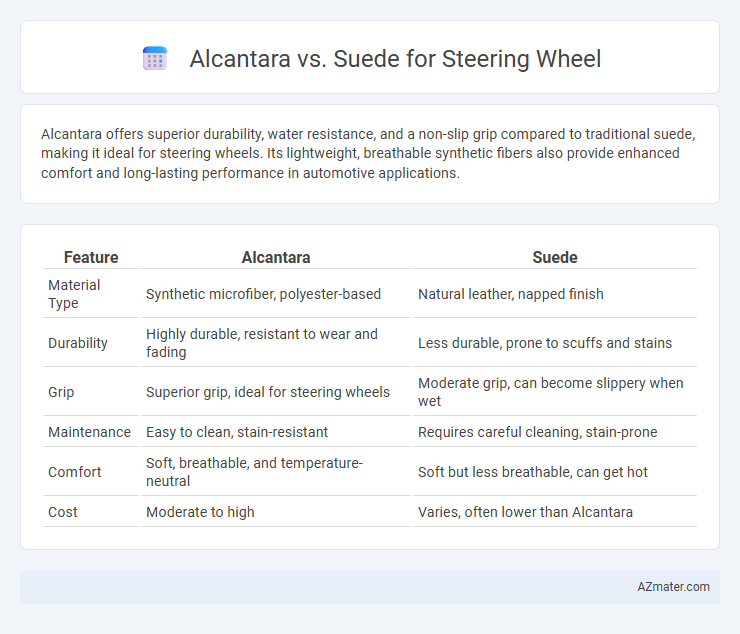Alcantara offers superior durability, water resistance, and a non-slip grip compared to traditional suede, making it ideal for steering wheels. Its lightweight, breathable synthetic fibers also provide enhanced comfort and long-lasting performance in automotive applications.
Table of Comparison
| Feature | Alcantara | Suede |
|---|---|---|
| Material Type | Synthetic microfiber, polyester-based | Natural leather, napped finish |
| Durability | Highly durable, resistant to wear and fading | Less durable, prone to scuffs and stains |
| Grip | Superior grip, ideal for steering wheels | Moderate grip, can become slippery when wet |
| Maintenance | Easy to clean, stain-resistant | Requires careful cleaning, stain-prone |
| Comfort | Soft, breathable, and temperature-neutral | Soft but less breathable, can get hot |
| Cost | Moderate to high | Varies, often lower than Alcantara |
Introduction: Alcantara vs Suede Steering Wheels
Alcantara and suede are popular materials for steering wheels, valued for their luxurious feel and enhanced grip. Alcantara offers superior durability and resistance to wear, moisture, and UV exposure compared to traditional suede, making it ideal for high-performance and daily driving environments. Suede provides a softer, more textured surface but tends to require more maintenance to prevent wear and staining over time.
Material Overview: What is Alcantara?
Alcantara is a premium synthetic material composed of polyester and polyurethane fibers, designed to replicate the softness and durability of natural suede. Known for its lightweight, breathable, and stain-resistant properties, Alcantara offers superior grip and comfort, making it ideal for steering wheel covers in performance vehicles. Unlike traditional suede, Alcantara maintains its appearance and texture over time, resisting wear from constant handling and exposure to sunlight.
Suede Explained: Origins and Characteristics
Suede, derived from the underside of animal hides, particularly lamb, goat, or calf, offers a soft, napped finish valued for its luxurious texture and grip, making it a popular choice for steering wheels. Its porous surface provides excellent breathability and tactile feedback, enhancing driver control and comfort during extended drives. Despite its elegance, suede requires careful maintenance due to susceptibility to moisture and dirt, distinguishing it from synthetic options like Alcantara in durability and care.
Durability Comparison: Alcantara vs Suede
Alcantara offers superior durability over suede for steering wheels due to its synthetic microfiber composition, which resists wear, stains, and fading more effectively. Suede, made from natural leather fibers, tends to absorb oils and moisture, leading to quicker wear and discoloration under frequent hand contact. The enhanced abrasion resistance of Alcantara ensures a longer-lasting, grippier surface optimized for performance driving conditions.
Grip and Comfort: Driving Experience Insights
Alcantara offers superior grip and breathability compared to traditional suede, enhancing control and reducing hand slippage during aggressive driving. Its synthetic microfibers provide a soft, durable texture that remains comfortable in both hot and cold conditions. Suede, while plush, often absorbs moisture and can become slippery, making Alcantara the preferred choice for performance-oriented steering wheels.
Maintenance and Cleaning Requirements
Alcantara steering wheels require gentle cleaning with mild soap and water, avoiding harsh chemicals to preserve the fabric's texture and appearance. Suede steering wheels demand careful maintenance with a specialized suede brush and cleaner to prevent staining and maintain softness. Both materials need regular, delicate care to avoid damage, but Alcantara is generally more resistant to wear and easier to clean than traditional suede.
Cost Analysis: Price Differences
Alcantara steering wheels typically cost 30-50% more than suede options due to superior durability and premium manufacturing processes. Suede remains a more budget-friendly choice, generally priced 20-40% lower, making it popular among cost-conscious buyers. The price gap reflects differences in material longevity and luxury perception, influencing long-term value and maintenance expenses.
Aesthetic Appeal and Customization Options
Alcantara steering wheels offer a modern, luxurious aesthetic with a matte, suede-like texture that enhances grip and resists fading, while traditional suede provides a classic, softer feel but may show wear more quickly. Alcantara can be customized with a wider range of colors and stitching patterns, allowing for unique, high-end designs tailored to individual preferences. Suede customization is typically more limited and often remains within natural or darker shades, making Alcantara the preferred choice for drivers seeking both style and personalization.
Popular Brands and Vehicle Applications
Alcantara, favored by luxury automotive brands such as Ferrari, Lamborghini, and Porsche, offers superior durability and a premium suede-like texture ideal for high-performance steering wheels. Suede, commonly used by brands like BMW M and Audi RS for their sportier models, provides a softer grip but tends to wear faster under rigorous driving conditions. Both materials enhance steering wheel grip and driver control, with Alcantara preferred for endurance in track-focused vehicles and Suede favored for comfort in daily-driven sports cars.
Which is Better? Final Verdict for Drivers
Alcantara offers superior durability, enhanced grip, and a luxurious feel, making it the preferred choice for performance-oriented drivers seeking comfort and control. Suede delivers a softer touch and classic aesthetic but tends to wear faster and shows stains more easily under heavy use. For steering wheels, Alcantara provides a better balance of longevity and performance, securing its position as the ideal material for drivers prioritizing both style and functionality.

Infographic: Alcantara vs Suede for Steering Wheel
 azmater.com
azmater.com